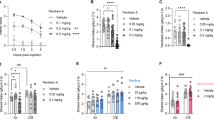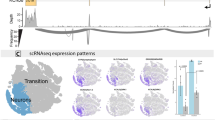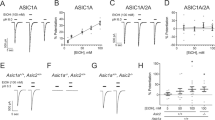Abstract
Ethanol modifies neural activity in the brain by modulating ion channels. Ethanol activates G protein–gated inwardly rectifying K+ channels, but the molecular mechanism is not well understood. Here, we used a crystal structure of a mouse inward rectifier containing a bound alcohol and structure-based mutagenesis to probe a putative alcohol-binding pocket located in the cytoplasmic domains of GIRK channels. Substitutions with bulkier side-chains in the alcohol-binding pocket reduced or eliminated activation by alcohols. By contrast, alcohols inhibited constitutively open channels, such as IRK1 or GIRK2 engineered to strongly bind PIP2. Mutations in the hydrophobic alcohol-binding pocket of these channels had no effect on alcohol-dependent inhibition, suggesting an alternate site is involved in inhibition. Comparison of high-resolution structures of inwardly rectifying K+ channels suggests a model for activation of GIRK channels using this hydrophobic alcohol-binding pocket. These results provide a tool for developing therapeutic compounds that could mitigate the effects of alcohol.
This is a preview of subscription content, access via your institution
Access options
Subscribe to this journal
Receive 12 print issues and online access
$209.00 per year
only $17.42 per issue
Buy this article
- Purchase on Springer Link
- Instant access to full article PDF
Prices may be subject to local taxes which are calculated during checkout








Similar content being viewed by others
References
Mihic, S.J. et al. Sites of alcohol and volatile anaesthetic action on GABAA and glycine receptors. Nature 389, 385–389 (1997).
Lovinger, D.M., White, G. & Weight, F.F. Ethanol inhibits NMDA-activated ion current in hippocampal neurons. Science 243, 1721–1724 (1989).
Cardoso, R.A. et al. Effects of ethanol on recombinant human neuronal nicotinic acetylcholine receptors expressed in Xenopus oocytes. J. Pharmacol. Exp. Ther. 289, 774–780 (1999).
Zhou, Q. & Lovinger, D.M. Pharmacologic characteristics of potentiation of 5-HT3 receptors by alcohols and diethyl ether in NCB-20 neuroblastoma cells. J. Pharmacol. Exp. Ther. 278, 732–740 (1996).
Harris, R.A., Trudell, J.R. & Mihic, S.J. Ethanol's molecular targets. Sci. Signal. 1, re7 (2008).
Wick, M.J. et al. Mutations of gamma-aminobutyric acid and glycine receptors change alcohol cutoff: evidence for an alcohol receptor? Proc. Natl. Acad. Sci. USA 95, 6504–6509 (1998).
Lewohl, J.M. et al. G protein–coupled inwardly rectifying potassium channels are targets of alcohol action. Nat. Neurosci. 2, 1084–1090 (1999).
Kobayashi, T. et al. Ethanol opens G protein–activated inwardly rectifying K+ channels. Nat. Neurosci. 2, 1091–1097 (1999).
Covarrubias, M., Vyas, T.B., Escobar, L. & Wei, A. Alcohols inhibit a cloned potassium channel at a discrete saturable site. Insights into the molecular basis of general anesthesia. J. Biol. Chem. 270, 19408–19416 (1995).
Blednov, Y.A., Stoffel, M., Alva, H. & Harris, R.A. A pervasive mechanism for analgesia: activation of GIRK2 channels. Proc. Natl. Acad. Sci. USA 100, 277–282 (2003).
Blednov, Y.A., Stoffel, M., Chang, S.R. & Harris, R.A. Potassium channels as targets for ethanol: studies of G protein–coupled inwardly rectifying potassium channel 2 (GIRK2) null mutant mice. J. Pharmacol. Exp. Ther. 298, 521–530 (2001).
Reuveny, E. et al. Activation of the cloned muscarinic potassium channel by G protein βγ-subunits. Nature 370, 143–146 (1994).
Wickman, K.D. et al. Recombinant G protein βγ-subunits activate the muscarinic-gated atrial potassium channel. Nature 368, 255–257 (1994).
Huang, C.L., Slesinger, P.A., Casey, P.J., Jan, Y.N. & Jan, L.Y. Evidence that direct binding of G βγ to the GIRK1 G protein–gated inwardly rectifying K+ channel is important for channel activation. Neuron 15, 1133–1143 (1995).
Kunkel, M.T. & Peralta, E.G. Identification of domains conferring G protein regulation on inward rectifier potassium channels. Cell 83, 443–449 (1995).
Krapivinsky, G. βγ binding to GIRK4 subunit is critical for G protein–gated K+ channel activation. J. Biol. Chem. 273, 16946–16952 (1998).
He, C., Zhang, H., Mirshahi, T. & Logothetis, D.E. Identification of a potassium channel site that interacts with G protein βγ subunits to mediate agonist-induced signaling. J. Biol. Chem. 274, 12517–12524 (1999).
Ivanina, T. et al. Mapping the Gβγ-binding sites in GIRK1 and GIRK2 subunits of the G protein–activated K+ channel. J. Biol. Chem. 278, 29174–29183 (2003).
Finley, M., Arrabit, C., Fowler, C., Suen, K.F. & Slesinger, P.A. βL-βM loop in the C-terminal domain of G protein–activated inwardly rectifying K+ channels is important for G(βγ) subunit activation. J. Physiol. (Lond.) 555, 643–657 (2004).
Hara, K., Lewohl, J.M., Yamakura, T. & Harris, R.A. Mutational analysis of ethanol interactions with G protein–coupled inwardly rectifying potassium channels. Alcohol 24, 5–8 (2001).
Pegan, S., Arrabit, C., Slesinger, P.A. & Choe, S. Andersen's syndrome mutation effects on the structure and assembly of the cytoplasmic domains of Kir2.1. Biochemistry 45, 8599–8606 (2006).
Kruse, S.W., Zhao, R., Smith, D.P. & Jones, D.N. Structure of a specific alcohol-binding site defined by the odorant binding protein LUSH from Drosophila melanogaster. Nat. Struct. Biol. 10, 694–700 (2003).
Nishida, M. & MacKinnon, R. Structural basis of inward rectification: cytoplasmic pore of the G protein–gated inward rectifier GIRK1 at 1.8 Å resolution. Cell 111, 957–965 (2002).
Pegan, S. et al. Cytoplasmic domain structures of Kir2.1 and Kir3.1 show sites for modulating gating and rectification. Nat. Neurosci. 8, 279–287 (2005).
Inanobe, A., Matsuura, T., Nakagawa, A. & Kurachi, Y. Structural diversity in the cytoplasmic region of G protein–gated inward rectifier K+ channels. Channels (Austin) 1, 39–45 (2007).
Rishal, I., Porozov, Y., Yakubovich, D., Varon, D. & Dascal, N. Gβγ-dependent and Gβγ -independent basal activity of G protein–activated K+ channels. J. Biol. Chem. 280, 16685–16694 (2005).
Vivaudou, M. et al. Probing the G-protein regulation of GIRK1 and GIRK4, the two subunits of the KACh channel, using functional homomeric mutants. J. Biol. Chem. 272, 31553–31560 (1997).
Zhang, H., He, C., Yan, X., Mirshahi, T. & Logothetis, D.E. Activation of inwardly rectifying K+ channels by distinct PtdIns(4,5)P2 interactions. Nat. Cell Biol. 1, 183–188 (1999).
Zhou, W., Arrabit, C., Choe, S. & Slesinger, P.A. Mechanism underlying bupivacaine inhibition of G protein–gated inwardly rectifying K+ channels. Proc. Natl. Acad. Sci. USA 98, 6482–6487 (2001).
Jenkins, A. et al. Evidence for a common binding cavity for three general anesthetics within the GABAA receptor. J. Neurosci. 21, RC136 (2001).
Huang, C.L., Feng, S. & Hilgemann, D.W. Direct activation of inward rectifier potassium channels by PIP2 and its stabilization by Gβγ. Nature 391, 803–806 (1998).
Peoples, R.W. & Ren, H. Inhibition of N-methyl-d-aspartate receptors by straight-chain diols: implications for the mechanism of the alcohol cutoff effect. Mol. Pharmacol. 61, 169–176 (2002).
Dildy-Mayfield, J.E., Mihic, S.J., Liu, Y., Deitrich, R.A. & Harris, R.A. Actions of long chain alcohols on GABAA and glutamate receptors: relation to in vivo effects. Br. J. Pharmacol. 118, 378–384 (1996).
Ramaswamy, S., Eklund, H. & Plapp, B.V. Structures of horse liver alcohol dehydrogenase complexed with NAD+ and substituted benzyl alcohols. Biochemistry 33, 5230–5237 (1994).
Svensson, S., Hoog, J.O., Schneider, G. & Sandalova, T. Crystal structures of mouse class II alcohol dehydrogenase reveal determinants of substrate specificity and catalytic efficiency. J. Mol. Biol. 302, 441–453 (2000).
Weinhold, E.G. & Benner, S.A. Engineering yeast alcohol dehydrogenase. Replacing Trp54 by Leu broadens substrate specificity. Protein Eng. 8, 457–461 (1995).
Thode, A.B., Kruse, S.W., Nix, J.C. & Jones, D.N. The role of multiple hydrogen-bonding groups in specific alcohol binding sites in proteins: insights from structural studies of LUSH. J. Mol. Biol. 376, 1360–1376 (2008).
Lu, T. et al. Probing ion permeation and gating in a K+ channel with backbone mutations in the selectivity filter. Nat. Neurosci. 4, 239–246 (2001).
Nishida, M., Cadene, M., Chait, B.T. & MacKinnon, R. Crystal structure of a Kir3.1-prokaryotic Kir channel chimera. EMBO J. 26, 4005–4015 (2007).
Yi, B.A., Lin, Y.F., Jan, Y.N. & Jan, L.Y. Yeast screen for constitutively active mutant G protein–activated potassium channels. Neuron 29, 657–667 (2001).
Sadja, R., Smadja, K., Alagem, N. & Reuveny, E. Coupling Gβγ -dependent activation to channel opening via pore elements in inwardly rectifying potassium channels. Neuron 29, 669–680 (2001).
Jin, T. et al. The βγ subunits of G proteins gate a K+ channel by pivoted bending of a transmembrane segment. Mol. Cell 10, 469–481 (2002).
Sarac, R. et al. Mutation of critical GIRK subunit residues disrupts N- and C-termini association and channel function. J. Neurosci. 25, 1836–1846 (2005).
Riven, I., Kalmanzon, E., Segev, L. & Reuveny, E. Conformational rearrangements associated with the gating of the G protein–coupled potassium channel revealed by FRET microscopy. Neuron 38, 225–235 (2003).
Ford, C.E. et al. Molecular basis for interactions of G protein βγ subunits with effectors. Science 280, 1271–1274 (1998).
Clancy, S.M. et al. Pertussis toxin–sensitive Galpha subunits selectively bind to C-terminal domain of neuronal GIRK channels: evidence for a heterotrimeric G protein–channel complex. Mol. Cell. Neurosci. 28, 375–389 (2005).
Ho, S.N., Hunt, H.D., Horton, R.M., Pullen, J.K. & Pease, L.R. Site-directed mutagenesis by overlap extension using the polymerase chain reaction. Gene 77, 51–59 (1989).
Dundas, J. et al. CASTp: computed atlas of surface topography of proteins with structural and topographical mapping of functionally annotated residues. Nucleic Acids Res. 34, W116–118 (2006).
Harpaz, Y., Gerstein, M. & Chothia, C. Volume changes on protein folding. Structure 2, 641–649 (1994).
Acknowledgements
We would like to thank Y. Kurachi for GIRK2 coordinates, M. Lazdunsky for GIRK2 cDNA, D. Clapham for GIRK4 cDNA, N. Dascal for m-Phos cDNA, S. Pegan for initial discussions on structure of IRK1-MPD and members of the Slesinger laboratory for helpful comments. This work was funded, in part, by a pre-doctoral National Research Service Award from the National Institute on Alcohol Abuse and Alcoholism (F31AA017042, P.A.), by the National Institute on General Medical Sciences (R01GM056653, S.C.), and by the H.N. & Frances C. Berger Foundation and the Salk Institute for Biological Studies (P.A.S.). The content is solely the responsibility of the authors and does not necessarily represent the official views of the National Institute on Alcohol Abuse and Alcoholism or the National Institute on General Medical Sciences.
Author information
Authors and Affiliations
Contributions
P.A.S. and P.A. designed the experiments and analyzed the data. P.A. conducted the molecular cloning, electrophysiology and imaging experiments. H.D. and P.A. collaborated on structural analysis and figure production. H.D. conducted modeling experiments. P.A., H.D. and P.A.S co-wrote and revised the manuscript. P.A.S and S.C. supervised the project.
Corresponding authors
Supplementary information
Supplementary Text and Figures
Supplementary Figures 1–5 (PDF 245 kb)
Rights and permissions
About this article
Cite this article
Aryal, P., Dvir, H., Choe, S. et al. A discrete alcohol pocket involved in GIRK channel activation. Nat Neurosci 12, 988–995 (2009). https://doi.org/10.1038/nn.2358
Received:
Accepted:
Published:
Issue Date:
DOI: https://doi.org/10.1038/nn.2358
This article is cited by
-
Alcohol reverses the effects of KCNJ6 (GIRK2) noncoding variants on excitability of human glutamatergic neurons
Molecular Psychiatry (2023)
-
Chloroform is a potent activator of cardiac and neuronal Kir3 channels
Naunyn-Schmiedeberg's Archives of Pharmacology (2020)
-
Ethanol-induced conditioned place preference and aversion differentially alter plasticity in the bed nucleus of stria terminalis
Neuropsychopharmacology (2019)
-
Domain insertion permissibility-guided engineering of allostery in ion channels
Nature Communications (2019)
-
Selective binding of a toxin and phosphatidylinositides to a mammalian potassium channel
Nature Communications (2019)



